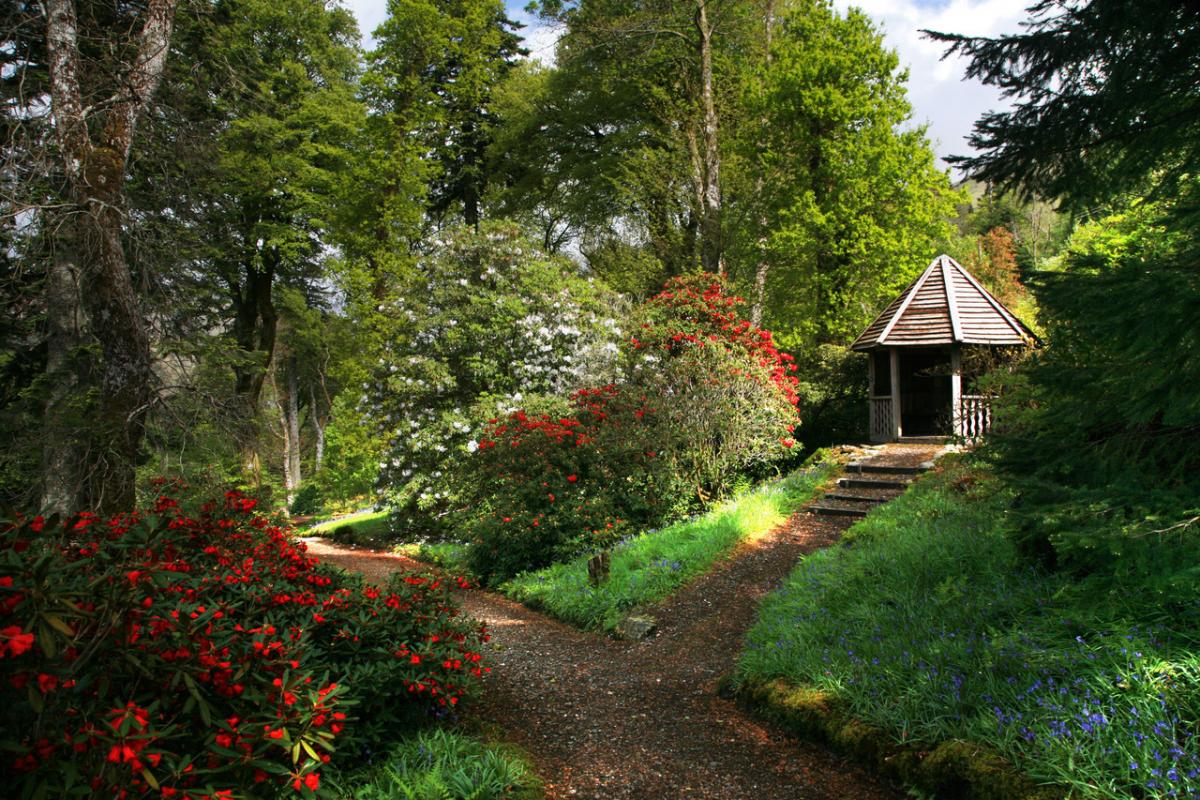Ardkinglas Woodland Garden
Cairndow
Argyll PA26 8BH
Why We Should Visit
The Christmas trees that sit in the corner of every living, draped in tinsel and baubles, are the domesticated version of real forest giants. Left to grow, these saplings would soar to impossible heights and at Ardkinglas Woodland Garden that’s exactly what has happened.
The damp, mild climate of Argyll has provided the ideal conditions for some of the world’s mightiest trees to flourish and in winter, when the woodland’s deciduous trees have dropped their leaves, these mighty firs can be seen at their best, dominating the landscape at the eastern end of Loch Fyne.
Story of the Garden
Before the influx of exotic conifers, Scots pine, yew and holly were this country’s only evergreens. Planting of trees from both North and South America, as well as from Asia, began at Ardkinglas during the 19th century and these grew quickly. In the early 20th century hundreds of rhododendrons were planted amongst them and Ardkinglas became renowned for its dense woodland and open spaces from where the trees could be admired.
Highlights
Ardkinglas is home to what has been described as ‘the mightiest conifer in Europe.’ The Abies alba has a girth of 10 metres. Many of Britain’s most immense trees grow here, including an Abies grandis, which so far has reached more than 64m, and a Patagonian cypress, still just a baby at 150 years old and 20m in height, which could live for more than 500 years, eventually reaching 70m.
Don’t Miss
From views down Loch Fyne, to red squirrels in the branches, Ardkinglas is a place to immerse yourself in the beauty of nature. The handsome house, designed by Robert Lorimer, is not open during the winter, but it makes a fine feature against the wooded slopes of Argyll.
Anything Else to Look Out For
With a Poetry Gazebo, walks through the woods and a Gruffalo Trail for children, Ardkinglas has all the ingredients for a great family day out. The garden is full of both unusual and native species, many of which only flourish because of the protected microclimate.
Best Time to Visit
Winter is the best time to appreciate the beauty of the estate’s conifers. In May, azaleas and rhododendrons dominate the scene and in late summer hydrangeas and a huge collection of sorbus take over.
Any Recommendations in the Area
Inverary, which can be seen from Ardkinglas, is one of Scotland’s most picturesque towns. Built in the 18thC by the Duke of Argyll, its whitewashed buildings hark back to the Jacobite era, when this part of the Highlands was at odds with the Crown.
Directions
The entrance to Ardkinglas is in the village of Cairndow, just off the A83 Loch Lomond to Inverary Road.
Details
£5/£2.50 (4-16)/ free (3 and under)
The woodland garden is open daily, dawn to dusk.
Soft petals and bright flowers are just a memory as winter gets underway, but the woodland surrounding some of Scotland’s best gardens offers a chance to get outdoors throughout the coldest months of the year.
At Greenbank Garden, near Clarkston on the southern edge of Glasgow, trails beneath the trees provide a sense of being in the middle of the countryside, while at Dumfries House in East Ayrshire, strolls along the Lugar Water have been enhanced by work going on to extend planting in the Arboretum, with more shrubs and camassias to give a vivid spring display.
The parkland around the dramatic ruins of Armadale Castle on Skye, left, are home to trees that have survived for more than a century and plantings of new conifers are being undertaken to help ensure the future of some of the world’s threatened species.
This designed landscape on Skye’s Sleat Peninsula is an atmospheric place to explore, especially during the winter months.
And so too is Scone Palace near Perth, below, which was the birthplace of plant hunter David Douglas, who introduced the Douglas Fir to Europe, the tree that would transform and the forestry industry.
The first Douglas Fir, grown from seed sent back by David Douglas himself, still grows at Scone today.
In association with Discover Scottish Gardens.
www.discoverscottishgardens.org.







Why are you making commenting on The Herald only available to subscribers?
It should have been a safe space for informed debate, somewhere for readers to discuss issues around the biggest stories of the day, but all too often the below the line comments on most websites have become bogged down by off-topic discussions and abuse.
heraldscotland.com is tackling this problem by allowing only subscribers to comment.
We are doing this to improve the experience for our loyal readers and we believe it will reduce the ability of trolls and troublemakers, who occasionally find their way onto our site, to abuse our journalists and readers. We also hope it will help the comments section fulfil its promise as a part of Scotland's conversation with itself.
We are lucky at The Herald. We are read by an informed, educated readership who can add their knowledge and insights to our stories.
That is invaluable.
We are making the subscriber-only change to support our valued readers, who tell us they don't want the site cluttered up with irrelevant comments, untruths and abuse.
In the past, the journalist’s job was to collect and distribute information to the audience. Technology means that readers can shape a discussion. We look forward to hearing from you on heraldscotland.com
Comments & Moderation
Readers’ comments: You are personally liable for the content of any comments you upload to this website, so please act responsibly. We do not pre-moderate or monitor readers’ comments appearing on our websites, but we do post-moderate in response to complaints we receive or otherwise when a potential problem comes to our attention. You can make a complaint by using the ‘report this post’ link . We may then apply our discretion under the user terms to amend or delete comments.
Post moderation is undertaken full-time 9am-6pm on weekdays, and on a part-time basis outwith those hours.
Read the rules here